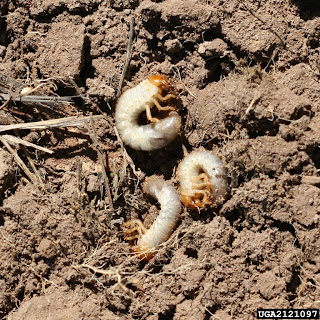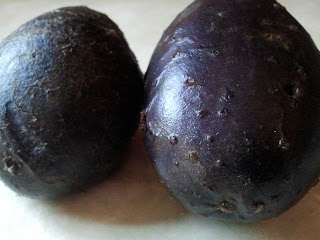May beetles are about 20 mm long. The adults often are yellow to dark reddish-brown, oblong, shining beetles. Some, such as the green June beetle, are more brightly colored.
The Phyllophaga life cycles vary somewhat because some species complete their growth in one year, while others require as much as four years. The common life cycle of the more destructive and abundant of these beetles extends over three years.
The adults mate in the evening and, at dawn, females return to the ground to deposit 15 to 20 eggs, 1 to 8 inches deep in the soil. Since the adults are attracted to trees to feed, they tend to lay most eggs in the higher portions of sod near wooded areas. Eggs hatch about three weeks later into young larvae that feed upon roots and decaying vegetation throughout the summer and, in the autumn, they migrate downward (to a depth of up to 1.5 meters) and remain inactive until the following spring. At this point in the insect's life cycle the greatest amount of damage occurs as the larvae return near the soil surface to feed on the roots of the plants. The next autumn the larvae again migrate deep into the soil to overwinter, returning near the soil surface the following spring (the third spring) to feed on plant roots until they are fully grown in late spring. These grubs then form oval earthen cells and pupation follows. The adult beetles emerge from the pupal stage a few weeks later, but they do not leave the ground. The beetles overwinter, emerging the following year in May or June when feeding, mating, and egg-laying take place.
Although white grubs can be a problem every year, the most serious damage occurs in regular three year cycles. The greatest damage to crops occurs the year after the appearance of the adults. During the years of heavy May beetle infestation, deep-rooted legumes, such as alfalfa or clovers, should be planted. If corn or small grains are present, every effort should be made to keep the field free of grass and weed growth, as this will reduce the number of eggs laid. The year following heavy flights of May beetles, planting corn or potatoes should be avoided in fields that were previously under sod or grass.
The Phyllophaga life cycles vary somewhat because some species complete their growth in one year, while others require as much as four years. The common life cycle of the more destructive and abundant of these beetles extends over three years.
The adults mate in the evening and, at dawn, females return to the ground to deposit 15 to 20 eggs, 1 to 8 inches deep in the soil. Since the adults are attracted to trees to feed, they tend to lay most eggs in the higher portions of sod near wooded areas. Eggs hatch about three weeks later into young larvae that feed upon roots and decaying vegetation throughout the summer and, in the autumn, they migrate downward (to a depth of up to 1.5 meters) and remain inactive until the following spring. At this point in the insect's life cycle the greatest amount of damage occurs as the larvae return near the soil surface to feed on the roots of the plants. The next autumn the larvae again migrate deep into the soil to overwinter, returning near the soil surface the following spring (the third spring) to feed on plant roots until they are fully grown in late spring. These grubs then form oval earthen cells and pupation follows. The adult beetles emerge from the pupal stage a few weeks later, but they do not leave the ground. The beetles overwinter, emerging the following year in May or June when feeding, mating, and egg-laying take place.
Although white grubs can be a problem every year, the most serious damage occurs in regular three year cycles. The greatest damage to crops occurs the year after the appearance of the adults. During the years of heavy May beetle infestation, deep-rooted legumes, such as alfalfa or clovers, should be planted. If corn or small grains are present, every effort should be made to keep the field free of grass and weed growth, as this will reduce the number of eggs laid. The year following heavy flights of May beetles, planting corn or potatoes should be avoided in fields that were previously under sod or grass.
Late spring or early autumn plowing destroys many larvae, pupae, and adults in the soil and also exposes the insects to predators, such as birds and skunks. For this cultural practice to be effective, plowing must occur before the grubs migrate below the plow depth. No-tillage or reduced tillage crop management enhances grub populations.
Natural enemies that control these white grubs include parasitic wasps and flies in the genera Tiphia and Myzinum (Hymenoptera: Tiphiidae), and Pelecinus polyturator Drury (Hymenoptera: Pelecinidae), and the fly, Pyrgota undata (Diptera: Pyrgotidae). Also, Cordyceps fungus infects the grubs.
So these grubby little bastard's parents laid them in the ground last fall and left them to pop from their eggs on their own.
When they awoke, they discovered a feast.
A feast of Purple Peruvian Potatoes. Out of the forty to fifty expected potatoes, I salvaged these two.





No comments:
Post a Comment